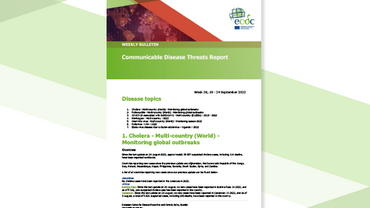Communicable disease threats report, 5-11 July 2015, week 28
The ECDC communicable disease threats report is a weekly bulletin intended for epidemiologists and health professionals in the area of communicable disease prevention and control. Summarising information gathered by ECDC through its epidemic intelligence activities regarding communicable disease threats of concern to the European Union, it also provides updates on the global situation and changes in the epidemiology of communicable diseases with potential to affect Europe, including diseases that are the focus of eradication efforts.
Executive Summary
This issue covers the period 5 to 11 July 2015 and includes updates on Schistosoma haematobium, West Nile fever, Ebola virus disease and Middle East respiratory syndrome – coronavirus (MERS CoV).
Schistosoma haematobium
In April 2014, a cluster of Schistosoma haematobium infections was detected. It was linked to freshwater exposure in 2013 at Cavu, a swimming area in southern Corsica, France. Following a national screening campaign in France, 110 additional schistosomiasis cases were described (as of 25 March 2015) in residents of Corsica and visitors from other parts of France, over a two-year time span. The majority of these cases were recorded in children and teenagers.
The no-swim advisory for the Cavu river area was lifted on 4 June 2015 by the prefecture of Corse-du-Sud. However, based on newly identified cases due to autochthonous transmission in 2014 and the presence of a zoonotic reservoir, the French National Agency of Health Security for Food, Environment and Labour issued recommendations that the no-swim notice should be reinstated. Epidemiological investigations are ongoing.
ECDC published a rapid risk assessment in May, 2014.
West Nile fever
As of 9 July 2015, one human case of West Nile fever (WNF) in the EU has been reported by Bulgaria. No cases have been recorded in neighbouring countries since the beginning of the 2015 transmission season.
The detection of a WNF case in Bulgaria is not unexpected. The country reported a case in 2012 in Burgas province and is surrounded by countries that have reported WNF cases in previous years. However, this probable case (in accordance with the EU case definition) is the first case of the current transmission season reported in the EU.
From week 23 onwards, ECDC will produce weekly West Nile fever (WNF) risk maps during the transmission season (June to November) to inform blood safety authorities of WNF affected areas.
Ebola virus disease (EVD)
According to the latest WHO situation report published on 8 July 2015, there were 30 confirmed cases of EVD reported in the week up to 5 July: 18 in Guinea, three in Liberia, and nine in Sierra Leone. This is the highest weekly total since mid-May. However, a decreasing proportion of cases (five of 30) arose from unknown sources of infection, particularly in previously problematic areas such as Boke and Forecariah in Guinea, and Kambia and Port Loko in Sierra Leone.
As of 7 July 2015, WHO reported 27 621 cases of Ebola virus disease related to the outbreak in West Africa, including 11 268 deaths.
Middle East respiratory syndrome - coronavirus (MERS-CoV)
Since the last CDTR on 3 July, South Korea has reported two additional cases and two deaths, bringing the number of cases to 186, including 35 deaths.
On 6 July 2015, the Department of Health in the Philippines reported a laboratory-confirmed case of MERS in a Finnish citizen who had travelled in the Middle East before arriving in the country. The patient is currently in a stable condition.
The Health Security Committee/Early Warning and Response System has published a statement on MERS-CoV infection and advice with regard to travelling.
On 30 June, ECDC published an updated rapid risk assessment.
Download






